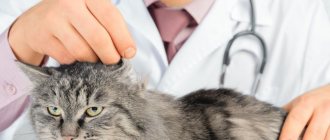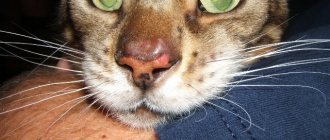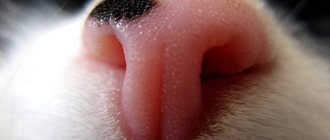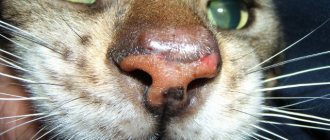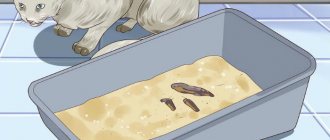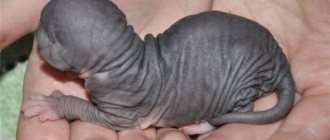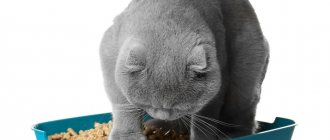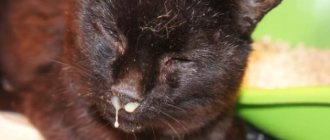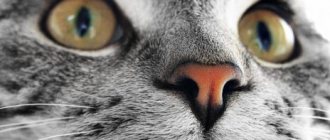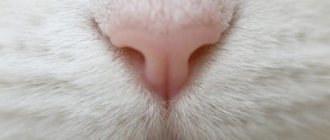What should a healthy cat's nose look like?
Veterinarians are sure: a healthy cat’s nose is cool and moisturized, because he endlessly licks it, and the body secretes a special secretion that prevents the nasal sinuses from drying out.
There are times when the animal is not sick, but its nose is warm and dry.
- The pet was in the open sun for a long time.
- The air in the room is very dry or the cat has been sitting next to the radiator for a long time.
- The animal is sleeping or has recently woken up.
- The cat had been active in the last few minutes, his body temperature had increased and his nose had become dry.
- The animal mainly leads a passive lifestyle.
- The pet was very frightened by something and was under great stress.
The above reasons are not dangerous to the life and health of the pet, so there is no need to worry. You need to worry if the cat is usually energetic and cheerful, but suddenly becomes lethargic and passive.
What are the causes of low-grade fever?
Failure in the thermoregulation system of a child’s body can be caused by various negative factors, such as changes in air temperature, stress, hormone imbalance or taking medications. These reasons may cause a one-time failure and do not pose a serious health hazard.
An alarming “bell” for parents is repeated temperature rises, or if the elevated temperature lasts for a long time. The reasons can be divided into two large groups:
- Infectious. Infection in 80% of cases is the cause of dysfunction of the thermoregulatory center. The general symptoms are complemented by catarrhal symptoms and signs of intoxication.
- Non-infectious. This group includes systemic diseases, the postoperative period and the period after vaccination, heat stroke, and trauma.
Thus, low-grade fever is the result of a restructuring of thermoregulatory processes, which occurs due to the introduction of infection, allergies or other influences into the body.
Why might a cat have a hot and dry nose?
The normal temperature of domestic cats is 38-39° C, so owners often think that their pets have a dry, hot nose. If the sinuses remain excessively hot and dry for a long time, you need to take a closer look at the animal.
Be sure to read:
What to do, the cat is sneezing, the eyes are watery or festering, reasons
Your cat may be dehydrated or have a fever.
Additional signs indicating the disease:
- loss of appetite;
- hot ears;
- apathy;
- loss of activity;
- sneezing;
- frequent pulsation;
- sleeping too long;
- frequent visits to the toilet;
- causeless anxiety;
- vomit;
- atypical nasal discharge;
- loose stools mixed with blood, etc.
The cat must be urgently taken to the veterinarian or called to your home. Do not self-medicate - you may make the situation worse.
Attention! Many inexperienced breeders recommend giving their pets Paracetamol to reduce fever. This cannot be done - the drug is toxic to felines and can be fatal!
A cat's nose is a mirror of health
Having discovered that their beloved cat’s nose has suddenly become hot and dry, most owners begin to worry whether the animal is sick. Don't rush to conclusions - a cute cat's nose may well deceive you.
The "mirror" of a cat's nose reflects the state of its health
You need to understand that your pet's nose can become moist due to two factors: due to the secretion of the nasal glands or simply due to the fact that the cat often licks it. This is how she regulates the operation of her individual temperature sensor, which is essentially the “mirror” of the nose. The sensitive skin on it and the epithelium in the nostrils are protected by physiological lubrication - if this does not happen, numerous receptors that are responsible for the sense of smell may be damaged. Therefore, prolonged dryness and elevated temperature of a cat’s nose is a signal of a malfunction in the normal functioning of its body.
Don’t forget that your pet cat is a descendant of wild hunters, whose wet nose helped determine the direction of the wind and “catch” the smell of prey.
What kind of nose should healthy cats have?
A healthy pet's nose should be moderately warm and slightly moist - this is considered a physiological norm. But here there are some nuances. In some cat breeds, for example, Bengals, a dry nose is a natural breed characteristic, which in this case is precisely an indicator that the cat is healthy. But in Persians, on the contrary, the nose may seem excessively wet - the fact is that this breed has a flattened muzzle and after ordinary cat licks, the nose remains wet longer.
A Bengal cat by nature should have a slightly dry nose.
Even what type of feeding your pet is on can affect how wet the nose is. It has been noticed that cats who eat mainly dry food have a wetter nose than those who eat natural food. The fact is that animals that consume “drying” need to drink more, and accordingly they urinate and lick their nose more often.
A healthy cat that is in good physical and psychological shape should have a nose no hotter than its body temperature, moisturized, not change its normal color and have a uniform, elastic skin structure on the lobe.
By constantly licking its nose, the cat moisturizes it
A cat’s nose may seem hot solely based on our subjective sensations, because the animal’s body temperature is two degrees higher than a human’s. A wet nose is always cooler than a too dry one, because moisturizing the earlobe also helps to cool it.
When a dry and warm nose is the norm
There are many moments in which a hot and dry nose should not alarm you at all. This state is natural for a cat that has just woken up: its temperature balance is just adjusting from sleep to wakefulness, and very soon everything will return to normal.
After sleep, your cat's nose is hotter than usual
Also, increased temperature and dry nose may indicate that:
- the cat is hypothermic or, conversely, overheated;
- the nose is dirty and cannot secrete natural secretions;
- the animal leads a sedentary lifestyle;
- the cat was in the sun for a long time on a hot day;
- the air in the room is too dry or stagnant;
- the pet is scared or is experiencing stress for some reason;
- the cat is in labor or has recently given birth to kittens.
In all these cases, the “sensor” of the cat’s nose will not be in an alarming state for long - feel it after a while and make sure that there is no reason for concern. But if the symptoms do not disappear over a long period and other signs of ill health are added to them, this is where you really should be concerned, find the cause of your pet’s condition - and take urgent measures.
Touch the cat's nose several times - how long does it stay hot?
A hot and dry nose in a cat or cat as a sign of disease
There are, of course, situations when you should urgently pay close attention to such symptoms and their accompanying signs:
- the cat sneezes and its nose has become too dry or too wet (snot has appeared) - this indicates the onset of a cold;
- the cat rubs its nose and eyes with its paws, tearing appears - perhaps this is how an allergy manifests itself (most often to chemicals used in cleaning);
- cracking, ulcers, and crusts form on the nose - these are signs of a dermatological disease;
- in addition to the nose, the ears became hot and red, the paws and skin in the groin became hot - the temperature increased;
- the animal is very thirsty;
- the nose changes color - turns red, blue or pale;
- breathing and heart rate noticeably increase;
- vomiting and diarrhea appear - especially dangerous if there is blood in the stool;
- the cat becomes lethargic, apathetic, refuses to eat - it looks like she is sick, you need to urgently measure the temperature, but not with your fingers, but with a thermometer.
A sick cat's nose may be damaged
Your pet's personal belongings should include his personal thermometer. Electronic is better than mercury - it is safer and gives readings faster. It is clear that the cat’s temperature is measured not in the armpit or in the mouth, but in the anus. A range of 38–39 degrees is considered normal. Temperatures up to forty degrees should not be brought down with medication.
The thermometer is not placed under the cat's armpit, but inserted into the anus
A dry, hot nose can be one of the manifestations of a serious illness. But, as a rule, this is far from the only and not the first symptom of the disease - other, more obvious signs will also signal it. Prolonged dryness and increased temperature of the cat's nose can be part of the overall clinical picture with the following problems, for example:
- dehydration of the body;
- infection;
- kidney disease;
- poisoning, digestive disorders, excess hair in the gastrointestinal tract;
- internal pathology;
- tumor.
When is a dry nose a sign of illness?
A dry cat's nose is often a sign of illness. One of the reasons is a stomach clogged with hairballs. Buy special food for hair removal at the pet store.
Collecting seeds in a tray will also help: just fill the tray with water according to the instructions, and in a few days your pet will be enjoying the young grass. With the grass, the fur accumulated in the stomach comes out of the animal’s body.
Owners often complain that their cat eats too much. Her body cannot cope with large doses of food, which leads to a malfunction in the digestive system and is manifested by dry sinuses. It's easy to combat overeating - put in a bowl as much food as she can eat during the day.
In addition to the nose, the ears are a clear indicator of a pet’s health. If they are hot and pink on the inside, this is a sign of illness. Take the animal to a veterinarian. Observe your pet - poor appetite and apathy towards toys also indicate illness. Call the doctor!
What symptoms should parents be wary of?
If in children under the age of one year a temperature of 37.2°C is considered normal, then as the child grows older, such indicators cease to be considered normal. As a rule, in addition to an increase in body temperature to subfebrile levels, the child may be bothered by:
- lethargy and apathy, the baby is not as active as usual;
- poor appetite, refusal of food and water;
- restless sleep, nervousness and moody behavior before bedtime;
- increased sweating, clothes become wet after sleep;
- confusion and rapid breathing.
We draw the attention of parents to the fact that the temperature does not indicate the severity of the disease. The symptoms listed above speak about this best.
What to do if your cat has a dry nose?
Hyperthermia is the main ailment in cats, leading to a dry nose. Observe your pet for 2-3 hours: how and how much she eats, whether she goes to the toilet, whether she is playful or apathetic, etc.
Be sure to read:
The kitten sleeps constantly: physiological and pathological reasons, what affects when to sound the alarm
If the animal's lethargy does not go away, contact your veterinarian. Also, do not delay a visit to the doctor if the cat does not allow you to touch its stomach, breaks out, scratches, or yellow-green bubbles are periodically visible from its nose.
You can make your cat feel a little better by periodically applying something cool to her armpits and groin area. Also wet your pet's fur - this will slightly lower the body temperature. Do not diagnose your cat - this can only be done by a specialist.
Wait for the doctor, and while he is on his way to you, stay close to your pet. Talk kindly, stroke her head - she needs support.
Help your pet
A cat has a dry nose; how to help is the question every loving owner asks when the pet’s health worsens. But you really can and should help.
If you notice that your cat’s nose is cold and dry without any outside influence, and that she is coughing or sneezing, you need to measure the temperature rectally. An increased level will indicate the onset of a cold, which can still be confirmed by hot ears, and a decreased level may indicate shock or poisoning. In the case of a very high temperature, the animal will need the help of the owner, which will require him to:
- provide your pet with unlimited access to a drinking bowl with cool water, which will need to be changed periodically for fresh water;
- moisten the animal's fur with a wet towel;
- Apply an ice pack (briefly) under the neck and on the inner thighs.
If your cat’s body temperature rises above 38.5 degrees, you shouldn’t give any antipyretics on your own; it’s better to rush to the veterinarian. He will make the correct diagnosis and prescribe appropriate treatment.
Sometimes body temperature can increase when the animal is overheated, for example, sunstroke. At the same time, the cat falls into a state of apathy, it experiences a rapid heartbeat and shallow breathing. In this condition, the pet should be immediately placed in the shade, thoroughly and often wet its nose, ears and paws with cold water, providing access to cool fresh air.
What diseases can fever indicate?
We list possible diseases from simple to the most serious, which are manifested by low-grade fever:
- infectious diseases in chronic form: sinusitis, tonsillitis, otitis media, herpes;
- oncological: leukemia, lymphoma, hepatoma, etc.;
- autoimmune: arthritis, vasculitis, lupus, scleroderma;
- endocrine and metabolic disorders: diabetes mellitus, thyrotoxicosis, hyperthyroidism, pheochromocytoma, etc.;
- digestive tract infections: gastroenteritis.
How to alleviate the child's condition?
Several recommendations will help your child cope with this unpleasant condition. They are aimed at increasing heat transfer and reducing heat production. In practice, this can be done as follows:
- provide the child with bed rest or a minimum of physical activity;
- try to control the child’s emotions, screams and tantrums contribute to an increase in temperature;
- feed the child as desired, do not insist on feeding if he does not want to eat;
- Monitor the temperature of food, it is also better to avoid hot drinks (no more than 40°C);
- maintain an optimal climate in the room, namely about 20° (+/-2°);
- Give your child plenty of drink, it can be water, compote, juice, tea with raspberries.
These tips will help your child cope with low fever. However, parents should monitor the situation so that if the child’s condition worsens, they can take adequate measures.
What to do
At home, you can give your pet painkillers and antipyretics. It is not recommended to engage in treatment, since this requires first establishing a diagnosis. The temperature can only be reduced if it exceeds 40 degrees.
Respiratory viral disease
In this case, the temperature rises slightly - by 1-1.5 C. The exudate is usually mucous, light, and often watery. The animal does not feel very bad, does not refuse food, and shows some activity.
Broad-spectrum antiviral agents are widely used in treatment. Therapy is usually done without the use of antipyretic drugs.
Bacterial respiratory disease
The temperature rises significantly - by 1.5-2 C. The exudate is often thick and has a yellow, white or even green tint. Sometimes it gives off an unpleasant odor. The cough is severe and there is shortness of breath. The animal is passive, refuses to eat, constantly lies down, gets up only to go to the toilet or drink water.
At the beginning of the disease, the animal is given antitussives, since coughing in the absence of sputum only damages the bronchi. When exudate appears, expectorants are prescribed to help the mucus drain faster. Antibiotics and antipyretics must be used.
Sepsis
The temperature rises very strongly - by 2-3 C. The mucous membranes are red, sometimes with pinpoint hemorrhages. The animal feels very bad and does not respond to its owner. The pet is unable to even go to the toilet and relieves himself. Loss or confusion is common.
In this case, powerful systemic antibiotics are used. Be sure to use antipyretic and anti-inflammatory drugs. In addition, the pet must be hospitalized, as resuscitation may be required. Intravenous administration of maintenance medications, vitamins, glucose, and microelements is prescribed.
Helminthiasis
The temperature does not always rise. Severe diarrhea is often observed. Blood clots are found in the stool (if the intestinal mucosa is damaged), and the stool usually gives off a strong, unpleasant, putrid odor. Due to diarrhea, dehydration and dry mucous membranes develop.
Deworming is carried out. To do this, it is first advisable to establish the exact type of parasites. Otherwise, use complex agents that act against all types of helminths. In most cases, a single application is enough, but to ensure the destruction of parasites after 15 days, it is recommended to repeat deworming with a different drug.
Cardiovascular failure
The cat assumes a hunched position. Often presses front paws to chest. She does not respond to commands and freezes in one position for a long time. Shortness of breath often occurs; in severe cases, pale mucous membranes are observed due to a drop in blood pressure. Heart failure is diagnosed on an ECG.
Self-treatment is unacceptable. For complete therapy, it is necessary to establish the cause of the disease. After examination, the veterinarian may prescribe cardiac glycosides, anti-inflammatory or sedatives.
Pulmonary failure
The main symptom is shortness of breath and blue discoloration of the mucous membranes (lack of oxygen in the blood). Other signs are also possible: cough, the presence of exudate of varying consistency, color and odor, increased temperature. In severe cases, blood is found in the coughed up sputum, and tachycardia and loss of consciousness are added to the symptoms.
Self-treatment is unacceptable. For complete therapy, it is necessary to establish the cause of the disease. Anti-inflammatory, expectorant and antipyretic drugs, as well as antispasmodics, are often used.
Is it necessary to lower the temperature to 37.5 °C?
It's no secret that an increase in temperature is the body's immune response to infectious aggression that has entered the body. At elevated temperatures, pathogenic viruses and microbes die, so it is not recommended to bring it down to 38°C.
These thermometer readings are not a reason to take antipyretics; it is better to give the body the opportunity to use its own defense mechanisms as efficiently as possible.
It is possible to bring down a low-grade fever only if it is poorly tolerated by the child, there are signs of severe intoxication, or there is a high risk of developing cardiac complications. In such cases, it is necessary to consult a doctor as soon as possible.
However, at a temperature above 38.5°C, it is already worth taking measures to reduce it, as the situation may become more complicated.
How to diagnose and how to treat?
As a rule, diagnostic measures for a child with a complaint of low-grade fever include hardware and laboratory research methods:
- examination of ENT organs using appropriate instruments;
- blood test: general, serological and biochemistry;
- sputum examination;
- if necessary, radiography and CT;
- Ultrasound diagnostics;
- echocardiography.
Based on the results of a comprehensive examination, the otolaryngologist makes a diagnosis and makes appropriate prescriptions.
Residents of Kaliningrad can make an appointment with a pediatric otolaryngologist by filling out a preliminary application on our website or calling: +7 (4012) 357-773 or +7 (4012) 973-100.
